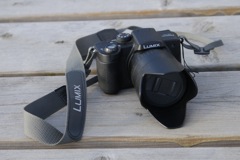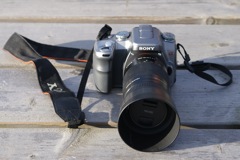
|
|
|
|
Photographing Model BoatsIntroductionI'm the person whose has taken the majority of photographs on this web site. On a number of occasions at the pond I've been asked about the cameras I use, so I thought I'd give some information here. While I've had previous experience of using 35mm film SLR cameras, I'm by no means a trained photographer, and furthermore, digital cameras are constantly evolving. Thus I will limit this discussion to my own cameras and the software that I use; if you are thinking of buying a new camera I strongly suggest that you do some detailed research on the web where there are many photographic review sites, for example the Digital Camera Resource. So, the aim of this article is to alert you to some of the points that you might wish to consider, and not to advise you on what to buy. So what is needed for photographing model boats?To state the obvious, model boats are relatively small, often some distance away, and sometimes fast moving. That implies that you need a camera with a "telephoto" zoom lens, but one that you can hand hold rather than having to use a tripod. Fortunately many modern cameras feature "image stabilisation" which makes the latter requirement feasible, even for someone like myself who does not have the steadiest of hands. My first "Model Boat Camera"
When I first started photographing model boats I was using a Panasonic "Lumix" DMC-FZ5 (right). This is a relatively small digital camera featuring a 12x zoom lens designed by Leica, and a 5 Mega-pixel sensor. It was first available around 2005. Advantages: The lens is equivalent (in 35mm terms) to a 36mm to 432mm zoom (with maximum aperture f2.8 to f3.3 for those who know about such things). It has excellent image stabilisation achieved by actively moving an element within the lens using (I believe) gyro stabilisation. It only weighs 380g (13.25oz). It has a "burst" mode allowing you to take up to 4 photographs (at the high quality setting) at 4 frames per second, or continuous shooting at 2 fps. It can shoot movies (with sound) at 320 x 240 pixel resolution (which is not that good) at either 10 or 30 frames/second. Disadvantages: Just how is that 12x zoom capability achieved? If you read the specifications on the front of the Leica lens, the actual focal length is 6mm to 72mm. It is because the electronic "CCD" sensor (which replaces the film in a non-digital camera) is only 10mm across that is equates to those impressive "35mm equivalent" figures. But a such a small sensor cannot gather as much light as a larger sensor (or, for that matter, a piece of 35mm film)i; the result is significant "digital noise", particularly under low light conditions. For composing your photo you can either use the LCD screen on the camera back, or an electronic viewfinder (EVF). I find that I can hold the camera much more steady using the EVF but the EVF has poor definition and, probably because I wear glasses, is hard to see in sunny conditions. Finally the camera has a noticable delay between pressing the shutter release button and taking the photo. No problem with most boats but with fast speed boats you need to aim a little in front of the bow to get the photo you want! By the way: the camera came with a 16Mb SD Memory card... which is not worth having. I bought a 1Gb card which will store about 400 fine resolution photos (although the battery life is probably only about 300 photos). It's worth balancing memory storage against battery life! Summary: The DMC-FZ5 proved a good camera and I've still kept it for use when travelling. In the Photo Galleries on this web site, any photo with a number starting with "P..." (or without a number starting "DSC...") would have been taken using it. Also the movies at Portsmouth Dockyard Model Ship Weekend, and of my "Wyeforce" tug. Looking at the Panasonic's web site, the present equivalent is the DMC-FZ28 which is a 10 Mega-pixel camera, with many improvements, but still with a relatively small sensor size. My next "Model Boat Camera"
It was mainly the shutter delay problem which made me change cameras although, in retrospect, the Lumix photos had a lot of digital noise compared to the photos that I take now. I chose a Sony Alpha 100 Digital Single Lens Reflex (DSLR) camera. SLR cameras have an optical system (a mirror and prism) so that when you look through the viewfinder you are actually looking through the camera lens and seeing what will be recordered when you press the shutter release. They feature exchangeable lenses so that you can choose the best lens "for the job". Why did I choose Sony? Apparently Sony had been keen to enter the digital camera market so when Minolta gave up the game, Sony bought them out. Sony cameras now feature Minolta compatible lens mounts. However the attraction for me was that the Sony camera featured "in camera" image stabilisation, achieved by moving the CCD image sensor to allow for camera shake. This contrasts with systems offered by some other, longer established, SLR camera manufacturers where the image stabilisation is built into each telephoto lens that they sell. Their advantage: the scene through the viewfinder is image stabilised (and the image stabilisation possibly better); the Sony advantage: the lenses are much cheaper but still benefit from image stabilisation. Advantages: Essentially: What you get with an SLR camera; bright, full definition optical viewfinder, no noticable shutter delay, interchangeable lenses. The lens I normally use for model boats is a 75mm - 300mm (f4.5 to f5.6) zoom. In 35mm terms it is equivalent to a telephoto lens of about 112mm to 450mm. While this is a more restricted range than the Lumix camera, that's because the CCD sensor is 23.6 x 15.8mm (APS-C) format. Compared to the Lumix sensor, this larger size means much less digital noise. And you've still got the long telephoto capability, although you've lost the wide angle ability. You've also lost "speed" in that the aperture (f4.5) is less but that is, to some extent, compensated for by the larger sensor. However also remember that you can swap lenses; the "standard" lens supplied with the camera is (in 35mm terms) an 27mm to 105mm (f3.5 - f5.6) zoom. The images are 10 Mega-pixels which gives more scope for cropping the photos and still maintaining acceptable resolution. A 2Gbyte SD memory card will hold 470 photos at "fine" resolution. The camera can be set to shoot at 3 frames per second for as long as the shutter release is held down. However there is no "movie" facility. Disadvantages: The camera (with 75mm - 300mm lens) weighs 1.18kg (2lb 9.5oz) which feels heavy. In swapping the lenses there is the danger of getting dust inside the camera. Whereas on a film camera, dust (and here we are talking about microscopic particles) might only effect one picture, for a digital camera, all subsequent photos are affected. In common with other DSLR's the Sony camera has a sensor cleaning system but it's not something that you might want to use too often. By the way: It was because of the dust problem that I recently bought a second camera body, an Alpha 200 which is really not much different to the Alpha 100. This means I don't have to swap lenses "in the field". I was going to buy the Alpha 350 which has a flip-out LCD screen but when I tried it in a shop, the extra thickness on the camera back meant (again as a glasses wearer) I had a poorer view through the viewfinder. Moral: always actually handle the camera before buying... even if you intend to buy on the web. As it turned out the best price I found was from Jessops who offer a "buy on the web, collect in store" service, very convenient. Summary: I've been very happy with the Sony cameras; any photos on the web site with a number starting "DSC..." would have been taken with them. Have a look! Processing SoftwareI have to admit that the photos taken by me and displayed on this web site do not represent exactly what I took when I was at the pond. First of all, most of the photos have been thrown away! What are left have been cropped, exposure levels adjusted, possibly sharpened, and possibly noise reduced. Although, because of my work connections, I have access to the Photoshop application (which is otherwise very expensive in it's full version), nowadays I use the Apple iPhoto application which comes free when you buy an Apple Mac. The version I use was part of Apple's "iLife 2008" package and allows one to do things like hide "blemishes" (e.g. a distracting bubble on the pond surface), for which one would previously have used Photoshop. Having chosen and editted the photos, iPhoto will output them in a web page format which I then change into the SRCMBC web site format (automatically, using "unix scripts"... but that's another story!). Overall SummaryTo repeat what I said in the introduction: these are the cameras I use, but they may not be the best choice for you. In choosing my present cameras, the priorities for me were: in camera image stabilisation, negligible shutter delay, good viewfinder for someone who wears glasses, and large CCD sensor size. Finally, although it's well worth checking prices on the web, I strongly suggest that you examine the camera(s) in a store (and if you've got a cheaper web price, don't be afraid to bargain!). |
